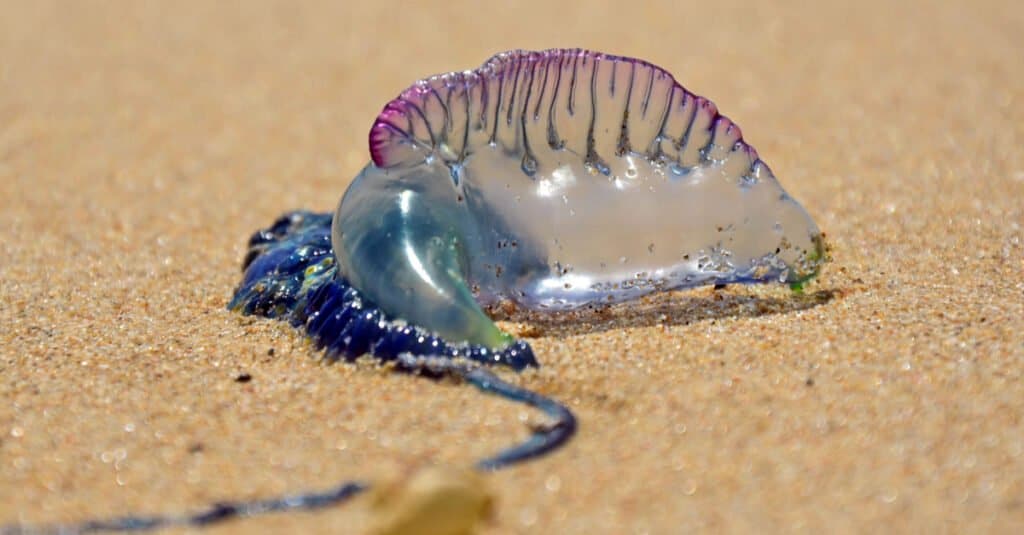Both the electric eel and the Portuguese man-o-war are frequently confused with animals they are not. These two dangerous marine critters are neither eels nor jellyfish. They are equally feared by folks who want to take a dip in the ocean, though. So, the question is, which of these nasty creatures could do more damage? Which is worse? Man-o-war vs. electric eel. Who would win?
Comparing a Man-O-War and Electric Eel

| Portuguese man-o-war | Electric eel | |
|---|---|---|
| Size | Max. 12-inch long bell, 30 to 160-foot tentacle | 6 to 8 feet long |
| Attack methods | Sting with highly toxic venom | Shock with up to 600-volt electrical charges |
| Speed | Floats | Swims and jumps quickly |
What Are Key Differences Between a Man-O-War and an Electric Eel?

The man-o-war has a nasty sting, even after death. But is that killer enough to take out an electric eel?
©KarenHBlack/Shutterstock.com
While both the man-o-war (Physalia physalis) and the electric eel (Electrophorus electricus) use nasty stings to kill their prey, they have very different methods of attack. They’re also vastly different in size, distribution, and ability to harm other creatures.
What Are the Key Factors in a Fight Between a Man O War Vs. Electric Eel?
Besides the electric eel actually being a knife fish and the Portuguese man-o-war being a siphonophore, the marine creatures have significant differences in nearly every other way, as well.
Man-O-War Vs. Electric Eel: Size
When it comes to size, the man-o-war definitely wins the debate. While the body of the electric eel reaches between 6 and 8 feet, the Portuguese man-o-war has a tiny body but long extensions. The body, known as the bell or bladder, typically measures under 12 inches. But that single long fishing tentacle reaches out from the bell average about 30 feet in length. Some man-o-wars have had tentacles that measure more than 160 feet in length.
When it comes to size, the man-o-war wins.
Man-O-War Vs. Electric Eel: Attack Methods
Portuguese Man-o-War

Portuguese Man-O-War spends most of its life drifting along the water, stretching out its massively long single fishing tentacle to find, shock, and bring in dinner.
©iStock.com/aldorado10
Portuguese man-o-war contain a nasty venom in their tentacles, which they use for stinging their prey. This is part of why folks mistake these creatures for jellyfish. They use a feeding tentacle to stretch out, find prey, and sting the food with paralyzing venom. With the massively long tentacles, they are able to locate their dinner more easily than a lot of other creatures. The tentacle on a man-o-war delivers a painful sting capable of killing fish, injuring humans, and, if circumstances are right, even killing humans.
In most cases, the venom leaves behind a nasty mark and intense pain for 30 to 60 minutes in humans. If the person is allergic or sensitive, however, the venom may leave a lasting scar or, in very rare cases, cause death. Additionally, heart failure has been known to occur when someone with a compromised heart is stung. Deaths are so rare, though, that finding more than a handful of confirmed incidents proves challenging.
Electric Eel

Aggressive jumping can give the electric eel an advantage in a fight.
©iStock.com/stacey_newman
On the other hand, the electric eel uses three electrical organs to kill prey. The main organ creates the strongest charges while the other two create the weaker charges. The fish will identify its prey and then strike, using its electrical organs to create shocking pulses. In the water, the charge may not hurt as much for a larger target. In the case of larger victims, the fish will leap out of the water and slide along the body of its partially submerged target to direct a stronger shock to the creature. It then increases the voltage of the pulses as it continues its attack. The fish may generate a charge of up to 600 volts to stun and kill its prey. When it comes to humans and electric eels, most often, the human is fine when shocked by the fish.
The non-lethal shock will numb or temporarily paralyze the victim of the eel. This results in the victim drowning if they are in the water (fish, other marine life, etc.). On extremely rare occasions, the shock may cause cardiac arrest in humans (or other large mammals). And like with the Portuguese man-o-war, finding confirmed human deaths can be challenging. This is good news for us! However, they can still be a nuisance and a pain. While the man-o-war is not known to actively attack humans, electric eels have.
Winner: electric eel.
Bonus points for man-o-war: even after the colony is dead, the tentacles can still sting.
Man-O-War Vs. Electric Eel: Speed
Portuguese man-o-war live a life of floating and stretching out their tentacles to shock and kill prey. They aren’t fast swimmers, nor are they known for being aggressive. Instead, they get their prey by being in the right place at the right time, stretching out the tentacle, and sending out venom.
Electric eels, on the other hand, can be aggressive, have been known to attack humans, and will definitely defend themselves against both water-bound and terrestrial predators. In fact, because of their nasty sting, the electric eel only has humans and land mammals in dry seasons as predators. Their aggression saves their lives in many cases. The sting drives away mammals looking to snag a fishy snack.
Who Would Win in a Fight Between a Man-O-War and an Electric Eel?

Technically a fish, not an eel, the electric eel can out-swim the floating man-o-war any day. This speed gives the eel a huge advantage over the man-o-war and means it would likely win in a fight.
©Danny Ye/Shutterstock.com
The advantages an electric eel has over a Portuguese man-o-war would result in its status as winner. Man-o-wars are not as aggressive as electric eels. They have a much longer reach, though, which gives them a different advantage but still not enough. If a man-o-war latched onto an electric eel, the eel would be able to send electrical shock waves through the colony’s tentacle and bell, resulting in the colony letting go and giving up its prey.
If the two were pitted against each other, the electric eel would pull out its aggressive nature to attack and kill the man-o-war if it felt threatened. The electric eel’s speed also gives the fish a huge advantage over the man-o-war. Ultimately, we think the electric eel would win.
Overall winner: Electric eel.
Another Animal That Could Take Down an Electric Eel: Electric Eel Vs. Crocodile
While ultimately, we’ve seen crocodiles and caimans lose the electric eel, the right circumstances might result in a reptilian win. You can find a video battle in which the fish kills a caiman but the reverse isn’t likely true. The sheer pain caused by the electrical shock of the eel to other animals is bad enough that most will drop the fish and run. If they don’t and want to duke it out, they’ll get increasingly worse shocks. Eventually, the shock to the croc will numb or paralyze the reptile. If that isn’t enough, the animal could wind up with cardiac arrest or drowning in most cases.
But, if the croc came in for a chomp at just the right moment, it’s possible it could win. Not much else could.
The photo featured at the top of this post is ©
Thank you for reading! Have some feedback for us? Contact the AZ Animals editorial team.







